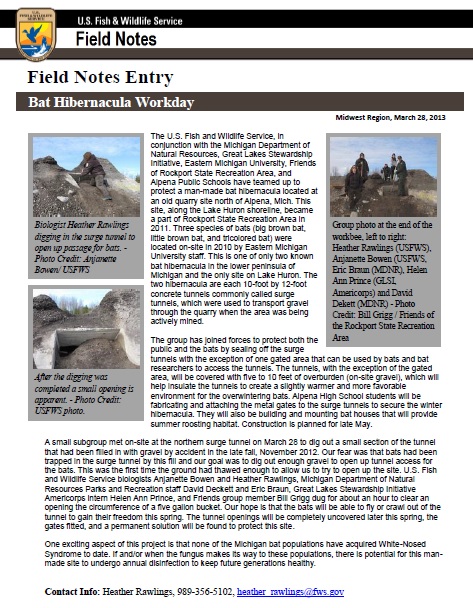March 28, 2013 - U.S. Fish and Wildlife Service
Click Here to read the official article on the U.S. Fish and Wildlife Service website.
The U.S. Fish and Wildlife Service, in conjunction with the Michigan Department of Natural Resources, Great Lakes Stewardship Initiative, Eastern Michigan University, Friends of Rockport State Recreation Area, and Alpena Public Schools have teamed up to protect a man-made bat hibernacula located at an old quarry site north of Alpena, Mich. This site, along the Lake Huron shoreline, became a part of Rockport State Recreation Area in 2011. Three species of bats (big brown bat, little brown bat, and tricolored bat) were located on-site in 2010 by Eastern Michigan University staff. This is one of only two known bat hibernacula in the lower peninsula of Michigan and the only site on Lake Huron. The two hibernacula are each 10-foot by 12-foot concrete tunnels commonly called surge tunnels, which were used to transport gravel through the quarry when the area was being actively mined.
The group has joined forces to protect both the public and the bats by sealing off the surge tunnels with the exception of one gated area that can be used by bats and bat researchers to access the tunnels. The tunnels, with the exception of the gated area, will be covered with five to 10 feet of overburden (on-site gravel), which will help insulate the tunnels to create a slightly warmer and more favorable environment for the overwintering bats. Alpena High School students will be fabricating and attaching the metal gates to the surge tunnels to secure the winter hibernacula. They will also be building and mounting bat houses that will provide summer roosting habitat. Construction is planned for late May.
A small subgroup met on-site at the northern surge tunnel on March 28 to dig out a small section of the tunnel that had been filled in with gravel by accident in the late fall, November 2012. Our fear was that bats had been trapped in the surge tunnel by this fill and our goal was to dig out enough gravel to open up tunnel access for the bats. This was the first time the ground had thawed enough to allow us to try to open up the site. U.S. Fish and Wildlife Service biologists Anjanette Bowen and Heather Rawlings, Michigan Department of Natural Resources Parks and Recreation staff David Deckett and Eric Braun, Great Lakes Stewardship Initiative Americorps intern Helen Ann Prince, and Friends group member Bill Grigg dug for about an hour to clear an opening the circumference of a five gallon bucket. Our hope is that the bats will be able to fly or crawl out of the tunnel to gain their freedom this spring. The tunnel openings will be completely uncovered later this spring, the gates fitted, and a permanent solution will be found to protect this site.
One exciting aspect of this project is that none of the Michigan bat populations have acquired White-Nosed Syndrome to date. If and/or when the fungus makes its way to these populations, there is potential for this man-made site to undergo annual disinfection to keep future generations healthy.

Biologist Heather Rawlings digging in the surge tunnel to open up passage for bats. - Photo Credit: Anjanette Bowen/ USFWS.
Group photo at the end of the workbee, left to right: Heather Rawlings (USFWS), Anjanette Bowen (USFWS, Eric Braun (MDNR), Helen Ann Prince (GLSI, Americorps) and David Dekett (MDNR) - Photo Credit: Bill Grigg / Friends of the Rockport State Recreation Area.

After the digging was completed a small opening is apparent. - Photo Credit: USFWS photo.

